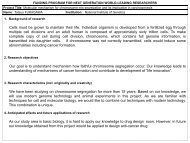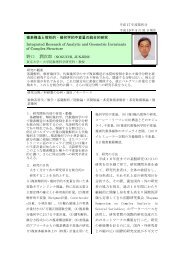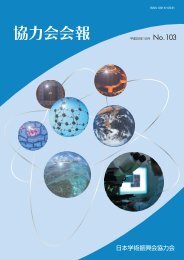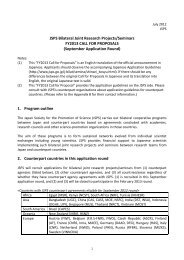"JSPS External Review Report" was issued.(PDF File 1.22MB)
"JSPS External Review Report" was issued.(PDF File 1.22MB)
"JSPS External Review Report" was issued.(PDF File 1.22MB)
Create successful ePaper yourself
Turn your PDF publications into a flip-book with our unique Google optimized e-Paper software.
eview system for the Grants-in-Aid for Scientific Research Program so that is able to accommodatea marked increase in future applicants.Multiple applications<strong>JSPS</strong> is lauded for the enhancements it has made to the review system and other aspects of theGrants-in-Aid for Scientific Research Program after receiving its transfer from MEXT. That said,the Committee would like to recommend that grant applications under the program be accepted anumber of times each year, rather than once a year as is the current practice. As the number ofapplication periods per year varies with culture and program characteristics between each country,the members do not wish to obligate <strong>JSPS</strong> to multiple application periods or to recommend a specificnumber of periods per year. However, by increasing the number of application periods, <strong>JSPS</strong>would be able to respond more quickly to rapidly emerging research themes and to accelerate theimplementation of research based on the excellent ideas of researchers. Accordingly, considerationshould be given to establishing a multiple-period application system, which could be phased in insome grant categories or done on an ad hoc recruitment basis. (It should be noted that a minorityopinion held that it is not important to set multiple application periods except in the case of extremelyurgent applications, for which special arrangements could be made.) Needless to say, increasingthe number of application periods will mean a considerable increase in <strong>JSPS</strong>’s workload. Steps willneed to be taken to realize the staffing augmentation recommended above in Section 3.Increasing budget versus maintaining qualityHaving witnessed large funding augmentations over recent years, the Grants-in-Aid for ScientificResearch Program is currently budgeted at 170 billion yen. Along with this expanded funding hascome a significant increase in the number of grant applicants. Basically speaking, this is desirablefor promoting science and meeting the needs of researchers. However, there is a possibility of rapidfunding increases yielding a decline in the standard of the funded research topics. Attention must,therefore, be given to maintaining the level of research quality while augmenting grant-in-aid funding.(3) University-Industry Cooperative Research ProgramUniversity-industry cooperation comes in many forms. Looking at countries other than Japan,there are those like the US in which close and direct cooperation is expected between universitiesand industry. On the other hand, there are systems like that in Germany where corporate funds donot flow directly to universities, but a certain amount of funds are transferred from industry to donorassociations. These funds are eventually used to support university research. Under this system,therefore, no university research program is regarded as being directly linked with specific corporateresearch. Considering the situation of scientific research in Japan, it cannot be detached from societaldemands, including those of industry; rather many excellent research themes are contained withinthe needs of the industrial sector. Therefore, it is advantageous for researchers in both universities34







